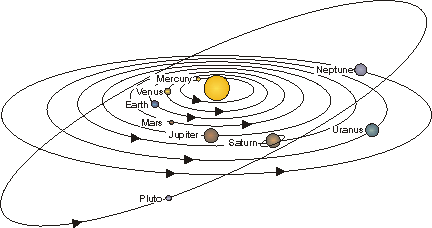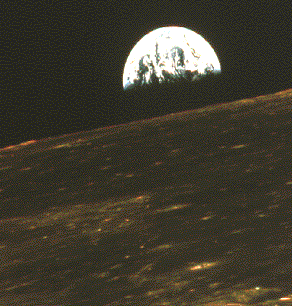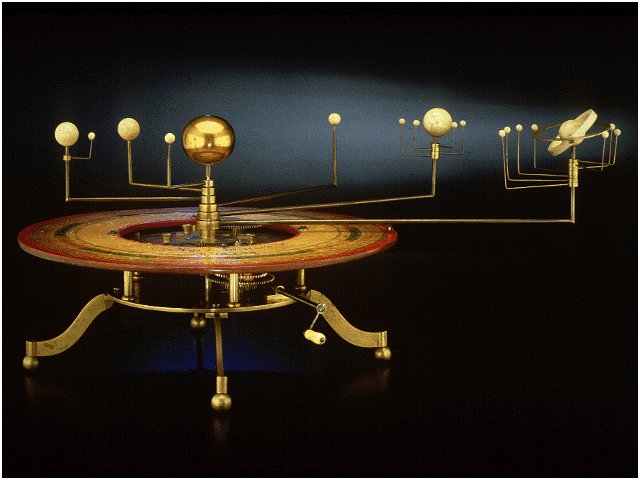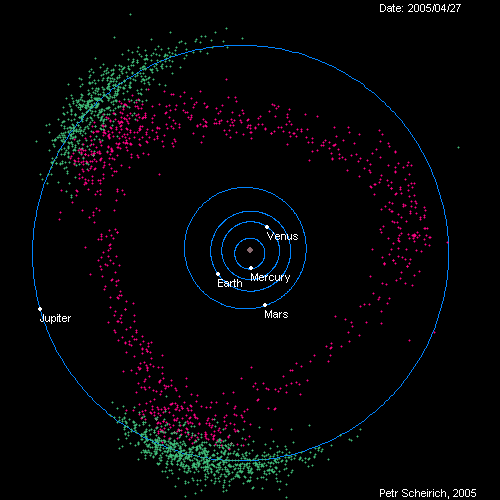
Macrocosm
"The solar system is so enormous as to justify the term "unimaginable": the marvel is that people have imagined it, and imagined it very accurately, accurately enough to plan journeys to the most distant planets. . . . "
Tim Radford, The Address Book, p. 169.
Solar System depicted with the orbital ellipses of the planets.
cosmos | platonic solids | the problem | Brahe's reconciliation | Kepler's laws | an answer | rarity of reality
The cosmos, is what the ancient Greeks interpreted as the order we apprehend in the universe. But observers did not actually comprehend that order precisely.
Kepler's earliest conception based on geometrical solids:
Applying the Platonic solids to the structure of the cosmos, Kepler arrived at the above model in 1596.
cosmos | platonic solids | the problem | Brahe's reconciliation | Kepler's laws | an answer | rarity of reality
The problem was how to describe mathematically the apparent movement of the inner as opposed to the outer planets.
A) inner planets are between the Earth and our sun, a star: Venus and Mercury. The apparent motion of Mercury is shown in the dotted purple line above.
B) outer planets are from the Earth to Pluto – the planetoid: Mars, Saturn were the only planets known to the ancients before the discovery of Uranus and Neptune.
cosmos | platonic solids | the problem | Brahe's reconciliation | Kepler's laws | an answer | rarity of reality
Tycho Brahe was a keen observer, for whom Kepler first worked, and Brahe devised this model to match his perfect star maps and his observations of the positions of the planets.
Brahe tried to reconcile the heliocentric with the geocentric views of the cosmos with this composite view -- a compromise where the earth remains the center of the "solar system" and all the rest of the planets move about the sun!
cosmos | platonic solids | the problem | Brahe's reconciliation | Kepler's laws | an answer | rarity of reality
| What is the accurate description? | |
 |
Kepler's three laws of planetary motion |
| • The orbit of every planet is an ellipse with the sun as one of two foci. | |
| (1609) | |
| • Any line within the ellipse joining the sun & the elliptical edge sweeps out equal areas in equal time intervals. | |
| (1609) | |
| • The square of the orbital period of every planet is proportional to the cube of the semi-major axis, or the longest diameter, of its orbit about the sun. | |
| (1619) | |
| Earth "rise" as seen from our moon. | |
cosmos | platonic solids | the problem | Brahe's reconciliation | Kepler's laws | an answer | rarity of reality
The answer is:
One view – planets orbit the sun.

An orrery: "This is a coined word for a clockwork model of the solar system, originally built for an aristocrat, the Earl of Orrery, in 1713. It is a geared instrument again with the sun at the center, and with little brass or painted representations of the planet revolving around it, showing where Mars, or Jupiter, or Saturn might be at any time in relation to the Earth."
Tim Radford, The Address Book, pp. 169-170.

Mike Brown, is an astronomer at Caltech. He wrote Robert Krulwich at NPR "that while everybody is busy hunting for an Earth-like planet, they missed this story. 'Before we ever discovered any [planets outside the solar system] we thought we understood the formation of planetary systems pretty deeply.' We had our frost line. We knew how solar systems formed. 'It was a really beautiful theory,' he says. 'And, clearly, thoroughly wrong.' "
"It is something I find deeply weird."
- Mike Brown, astronomer, Caltech
"As the discoveries roll in, Mike is getting more and more uncomfortable. Though it will take a while to discover smaller planets, right now there's only one planetary system that looks a lot like our own, he says. "HD 13931 b is nearly perfect. What I would desperately like to know is whether or not it has the small rocky bodies on the inside too. But it'll be a long time before we can find that."
Excerpted from Robert Krulwich's May 7, 2013 blog: "Our Very Normal Solar System Isn't Normal Anymore."
Petr Scheirich's 2005 drawing of how the inner planets move with respect to the earth and sun.
cosmos | platonic solids | the problem | Brahe's reconciliation | Kepler's laws | an answer | rarity of reality
Planet, from planeta is the ancient Greek word meaning "wanderer," since the Babylonians charted the irregular movement of these objects in the sky–when contrasted with the recurrent movement of stars–to determine the elapse of time throughout the year.
Galileo Galilei | Albert Einstein | Jacob Bronowski | Stephen Hawking | Ernst Mayr | Ian Tattersall | Charles Darwin
Terms | Glossary | Word webs | Basic vocabulary | Advanced Vocabulary | Antonyms | Synonyms